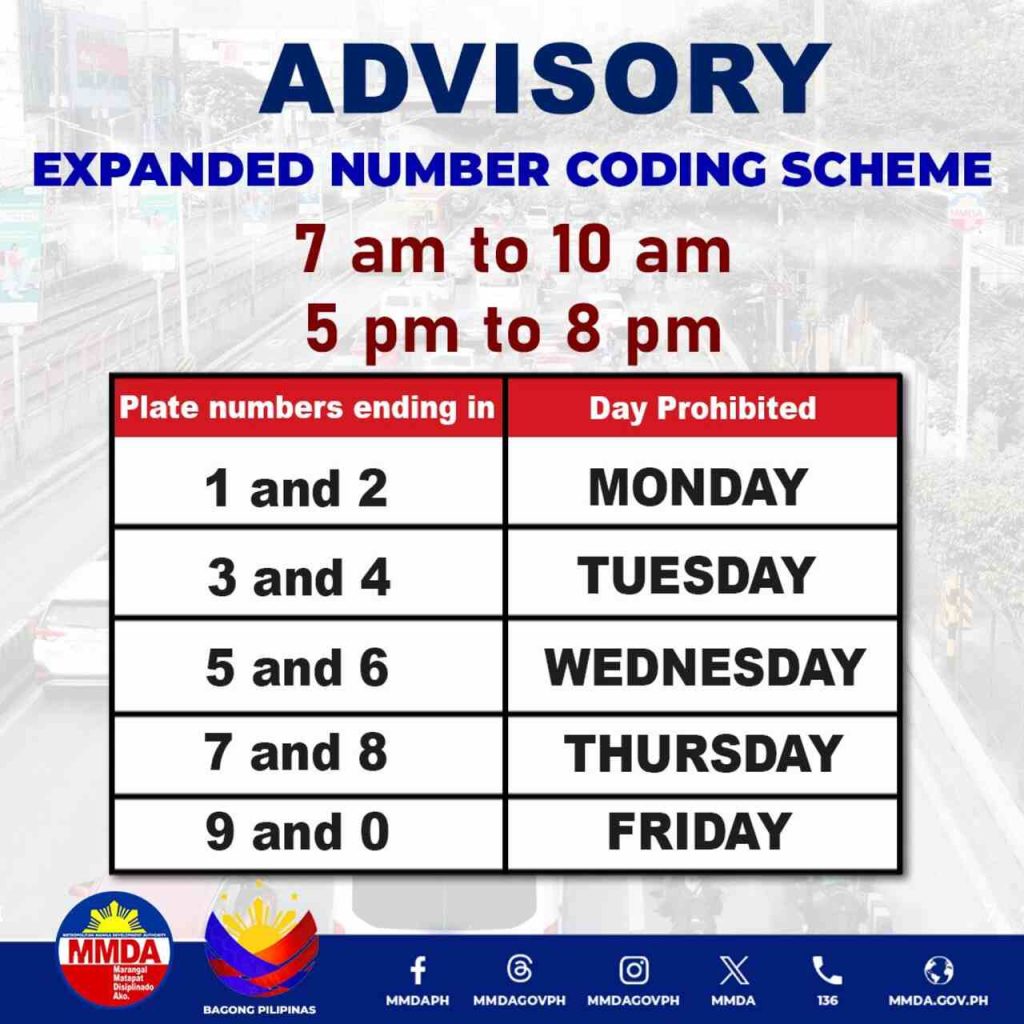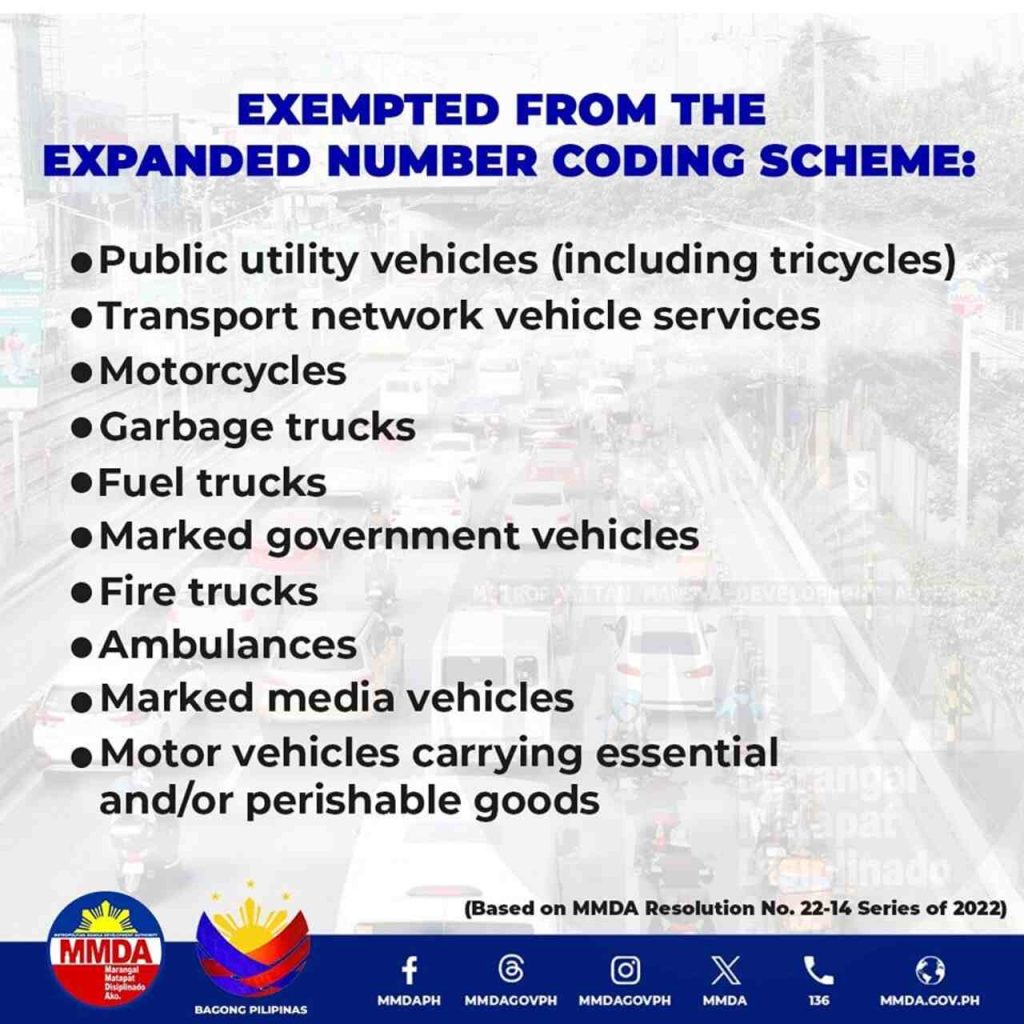The number coding scheme, officially known as the Unified Vehicular Volume Reduction Program (UVVRP), is a traffic management policy implemented by the Metropolitan Manila Development Authority (MMDA) in Metro Manila to reduce congestion on major roads. Introduced in the 1990s, it restricts certain vehicles based on the last digit of their license plate during peak hours on specific weekdays. The program aims to manage the increasing volume of vehicles, ease traffic flow, and improve air quality by limiting the number of cars on the road.
Understanding the coding hours is crucial for drivers to avoid penalties and ensure smoother travel within the metropolis. Those who violate the scheme risk fines and possible vehicle impoundment, which can disrupt daily commutes and schedules. Being aware of these restrictions helps motorists plan alternative routes, use public transportation when necessary, and contribute to a more efficient road system.
Current Number Coding Hours in Metro Manila

As per the latest MMDA directive, the number coding hours are in effect on weekdays (Monday to Friday) from 7:00 AM to 10:00 AM and 5:00 PM to 8:00 PM, except on public holidays. Vehicles with restricted plate numbers on a given day cannot be driven on major roads during these periods.
The number coding scheme in Metro Manila follows a day-specific restriction based on the last digit of a vehicle’s license plate. The restrictions are in place on weekdays, from Monday to Friday, during peak hours.
Here’s how the system works:
- Monday: Vehicles with plate numbers ending in 1 and 2 are not allowed on major roads.
- Tuesday: Those with plate numbers ending in 3 and 4 are restricted.
- Wednesday: Vehicles with last digits 5 and 6 cannot be on the road.
- Thursday: The restriction applies to cars with plate numbers ending in 7 and 8.
- Friday: Vehicles with last digits 9 and 0 are prohibited from driving.
However, there are certain cities within the metropolis that do not enforce the coding scheme. These include Taguig, Muntinlupa, and Pateros, among others.
Also, motorists are encouraged to always check for updates or changes in implementation, as special exemptions and adjustments may be announced by the MMDA.
Number Coding Rules for Brand-New Vehicles
The MMDA has also extended the coding scheme to include brand-new vehicles that do not yet have license plates. Instead, the last digit of the conduction sticker serves as the basis for coding restrictions. Car dealers and owners must keep the conduction sticker displayed on the vehicle’s designated plate space until the official LTO license plates are installed. Violators of this rule are subject to a fine of ₱300 per offense.
Exempted Vehicles from Number Coding
Certain vehicles are exempt from the MMDA UVVRP, including:

- Public utility vehicles (PUVs) such as buses, jeepneys, taxis, and tricycles
- Transport network vehicle services (TNVS) like Grab
- Motorcycles
- Marked government vehicles
- Ambulances and fire trucks
- Vehicles carrying perishable goods
- Media vehicles
- Fuel trucks and garbage trucks
Owners of exempted vehicles must ensure that they comply with other traffic laws while using Metro Manila roads.
Window Hours: When Are You Allowed to Drive?
Some areas in Metro Manila provide window hours, allowing restricted vehicles to be used during specific periods. In cities that implement window hours, vehicles covered by coding may still be driven between 10:00 AM and 3:00 PM. However, it is essential to check the local ordinances of each Local Government Unit (LGU), as policies may vary by city.
Local Government Units (LGUs) with Different Number Coding Rules
While the MMDA enforces the coding scheme on major roads, LGUs have the authority to implement their own regulations on secondary roads. Some areas may have different coding schedules, additional window hours, or full exemptions.
It is advisable to check with the respective LGUs to avoid penalties when driving through Metro Manila’s various cities.
Suspension of the Number Coding Scheme
The MMDA may suspend number coding under the following conditions:
- Official suspension announcements due to extreme weather conditions (flooding, storms, or earthquakes)
- Transport strikes
- National events or public holidays
- Presidential directives suspending work and classes
- Major events, or
- Emergencies
Motorists are encouraged to regularly check and monitor the official MMDA announcements through their official social media accounts and via reputable news outlets to stay updated on possible suspensions.
Fines and Penalties for Violating the Number Coding Scheme
Drivers caught violating the UVVRP will be issued a traffic citation ticket and fined ₱300 per violation. These penalties apply to both physical apprehensions by MMDA officers and non-contact apprehensions via traffic cameras. Repeated violations may lead to further penalties.
Frequently Asked Questions (FAQs)
For your reference, here are some common questions and answers regarding the number coding hours implemented in Metro Manila.
1. Can I apply for a one-day exemption from the number coding scheme?
Yes, the MMDA Chairman may grant one-day exemptions on a case-to-case basis. Applications must be submitted at least a day before the requested exemption date.
2. Are motorcycles included in the number coding scheme?
No, motorcycles are not covered by the UVVRP and can be driven at any time.
3. Does the coding scheme apply to private subdivisions?
No, private roads and gated communities do not enforce the MMDA coding scheme, but they may implement their own traffic rules.
4. Is the number coding scheme effective on holidays?
No, coding is automatically lifted on official public holidays.
5. Do ride-hailing services like Grab follow the number coding rule?
No, TNVS vehicles such as Grab are exempt from number coding and can operate freely.
Important Tips for Motorists
To avoid fines and inconvenience, vehicle owners may observe the following tips:
- Vehicle owners should plan their trips according to the coding schedule.
- If traveling during restricted hours is necessary, alternative routes or means of transportation should be considered.
- Regularly checking for updates on traffic regulations is also recommended, as policies may change.
- By following the number coding scheme, motorists can contribute to reducing traffic congestion and ensuring smoother road conditions in Metro Manila
Video: Number Coding Scheme, Exceptions, and Fines
The Metro Manila number coding scheme is a significant traffic management policy that aims to ease congestion on the city’s busiest roads. For a better understanding of the UVVRP schedule, exemptions, and penalties in Metro Manila, you may check out this video from MMDA.
For the latest updates on LTO regulations, MMDA guidelines, and Metro Manila traffic rules, always check official MMDA announcements or visit their website.